When I think of North Korea it’s about nuclear weapons, and an insular authoritarian dynasty that so many inhabitants want to flee. I’ve seen the documentaries, and watched in disbelief as I try to reconcile the stories of those who have escaped with the fact that the rest of the world no longer lives in the dark ages. Despite the rumour that unicorns exist in the country it’s the last place on earth I would consider visiting and until recently didn’t even realise that it was possible to be a tourist in this despotic land of mystery and fear. I actually believe I’d take a sun lounger and a package tour over an experience of the ‘big brother’ culture and complete lack of independence that comes with a trip to North Korea. Yet many people are interested to know what is it like to visit North Korea.
Earlier this year when our friend James announced he was off to Pyongyang, I thought he was joking. Surely people want to get out, not in! In fact I only really believed him when he returned a couple of weeks later with photographic evidence, and I was dying to know whether all the myths were true.
What is it like to visit North Korea…
Seriously, why visit North Korea?
Three years ago for Christmas I received the book Nothing to Envy: Real Lives in North Korea by Barbara Demick and was immediately hooked. The idea of the stalwart of Communism, a hermit nation seemingly cut off from the rest of the world, the cult-like idolisation of the Kim dynasty and the quirky myths was fascinating. I was totally obsessed and immediately went on to read every bit of literature I could find about DPRK (Democratic People’s Republic of Korea). Incidentally, never refer to DPRK as North Korea, they really do not like this!!
So how exactly do ‘ordinary people’ visit North Korea?
It’s much easier to visit North Korea than most people think, but it’s not cheap. A few specialist companies organise trips but the most established is the British run Koryo Tours based in Beijing. They have taken tourists into DPRK since 1992 and enjoy an excellent relationship with the Korean International Tourist Company (KITC). Koryo clearly have a love of the country and are involved in many humanitarian projects in DPRK. I travelled with Koryo and wouldn’t hesitate to recommend them.
They organise about 12 or 13 visits a year ranging from 2 day city breaks in Pyongyang (the trip I went on) to 14 day camping trips. Groups depart from Beijing accompanied by a Koryo guide, and on arrival in Pyongyang are met by two KITC guides (or three if there are USA nationals on the trip). There will always be a male and female guide and we found them to be lovely people who speak very good English. They are some of the very few DPRK nationals who have travelled internationally.
On the morning of travel from Beijing, Koryo issue you with your DPRK visa. This is stamped on arrival in DPRK and taken from you on departure. Your passport will not be stamped, and if you ask an official at the airport to stamp it they will just smile and tell you “not possible”. Incidentally, phones, cameras and passports are not confiscated at the border!
Pretty much anyone can visit DPRK, however journalists, higher ranking civil servants or military personnel may find they have to jump through a few more hoops before being granted a visa.
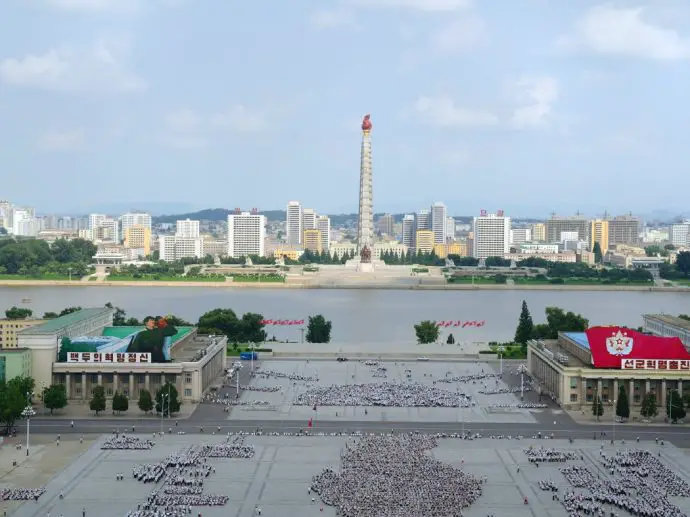
On your visa it says the year is 103, what’s that all about?
In DPRK 2014 is the year “Juche 103”, meaning it’s 103 years since Kim Il Sung was born. However for international correspondence they do use the international calendar too.
You stayed at the Yanggakdo Hotel, the tallest occupied building in Pyongyang. Is it really as mysterious as rumours suggest?
When people ask what is it like to visit North Korea, one of the first questions is about the famous hotel. It’s definitely the most bizarre place I’ve ever stayed. It’s almost like they sent someone to Vegas in 1984 and said “look what they’ve got, come back here and build it”. And they did but got it all a bit wrong … It’s located on an island in the middle of the Taedong river, so visitors can’t try to go walkabout unaccompanied in Pyongyang in the middle of the night! It has 4 restaurants, one of them revolving (although it never moved an inch when I was there), cinema, bowling alley, pool hall, swimming pool, casino, massage parlour, adult massage parlour(!) and an aquarium with an incredibly miserable turtle that has apparently been there for years. Despite there being over 1000 rooms and 47 floors, during my visit apart from our group there were only a handful of other guests. It was quite bizarre being in such a huge place which was practically deserted.
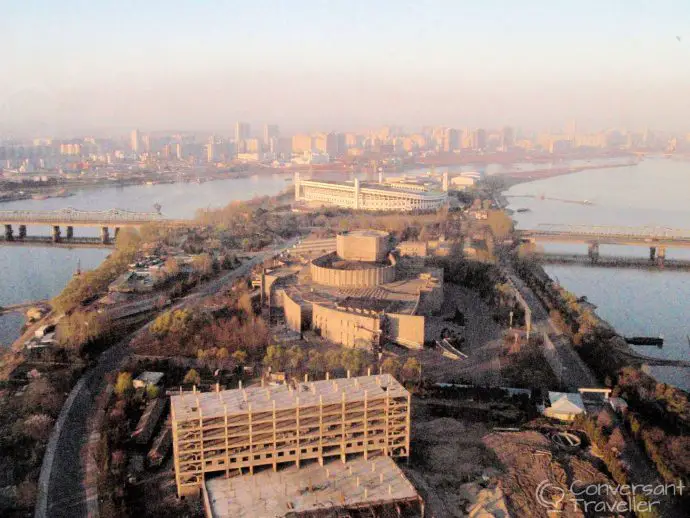
The 5th floor rumours are quite well known and guides smile when you ask about it. There is no 5th floor elevator button, and the Koryo guides advise you don’t try to use the stairs to reach it. The idea of Party members hidden away on the 5th floor doing covert surveillance on guests is laughed off by the KITC guide, who good naturedly declare “what do you think a bunch of tourists could say that would interest us?” Fair point I suppose, but I did get the impression that these rumours are best left in the past. However when it comes to the DPRK, expect anything and make up your own mind. After all, the most basic of clock radios in my bedroom had 5 thick cables going from the back of it into the wall!
The hotel room was clean and basic with a very hard bed, but when you consider where you are you cannot really complain. There were a few unexpected quirks, such as having BBC world service in the hotel room, and discovering (by accident) that despite the hotel having a modern key card system to open room doors, in reality ANY card will in fact open sesame, even a driving licence!
Most electricity goes off each day at 5pm, isn’t that a little hazardous?
After 5pm there are no street lights and very little light in the apartment blocks. Looking out of my hotel room window at 10pm the city was in total darkness, the only beacons of light being the various statues of the Kims and the Juche tower. Very strange and quite eerie. In the hotel we had electricity in the bar, corridor and rooms on the first night but on the second night we were told to be in our rooms before midnight which is when the electricity generator was switched off. A torch is essential for night time visits to the bathroom.
All our party were located on the 43rd floor, and for the duration of the stay this was the only floor which had lighting in the corridor. After checking in I shared the lift with a Korean lady who got off on a lower floor and I was surprised when she stepped out into pitch darkness flicking on a torch as she went. So naturally I pressed a few other buttons on the way up to 43…all were in darkness. The elevators in the Yanggakdo are also legendary by themselves due to the temperamental power supply (and perhaps questionable build quality). When you’re waiting for the lift to arrive the doors often open to reveal the lift car is 2 feet too high or too low, or not even there at all. Combine this with total darkness and it’s easy to see how accidents could happen!
So what is the Juche Tower in North Korea and why is it lit up at night?
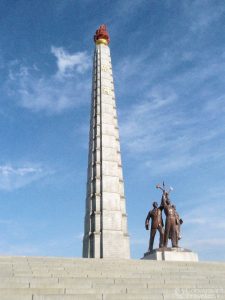
Juche is effectively the practised religion in DPRK, learned from infancy and based on Kim Il Sung’s theory of self reliance. Many volumes of Juche theory exist and citizens are expected to study it to the extreme throughout their entire lives.
Completed in 1982 to commemorate Kim Il Sung’s 70th birthday, the 170m Juche Tower comprises 25,550 granite blocks (one for every day of the Great Leader’s life) topped off with a 45 ton red metal torch. This torch is always illuminated through night as a mark of respect. At the base of the tower there are many plaques sent from various countries throughout the world acknowledging the brilliance of the Juche theory.
Other than Juche, there is no recognised practice of religion in DPRK, the only church or place of worship is in the Embassy complex.
North Korea isn’t known as a tourist destination, so besides the Juche Tower, what exactly was there to see?
I was under no illusions during the tour. I knew it would be series of statues and buildings built “because the people demanded it, to show their love and respect” for Kim Il Sung, Kim Jong Il and Kim Jong Un. Many of these monuments are built to commemorate the Korean War, in which the DPRK “defeated the evil invading Americans and their puppets the South Koreans” in 1955 (DPRK history books are very different to the rest of the world!). The first place we visited was the Pyongyang Heroes War Cemetery. It’s a bit like a smaller version of Arlington, but the headstones have pictures of the deceased. This was quite hard going for the American tourists as the venue guide was very anti-American. Phrases such as “murdered by the evil aggressors” were regularly used.
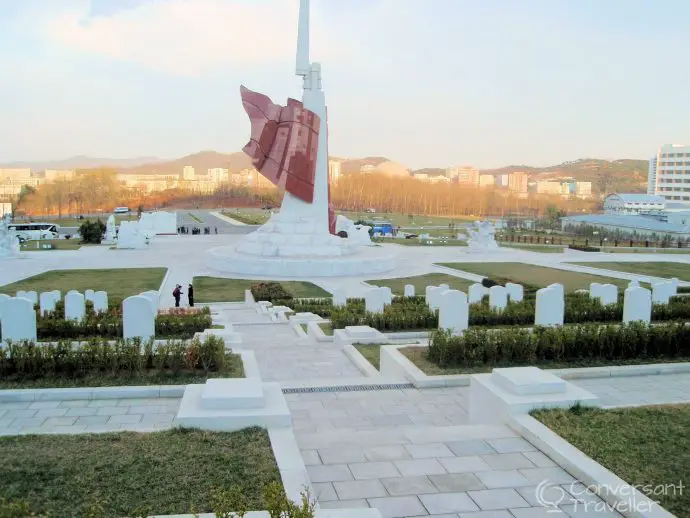
The Mansudae Grand Monument is a must see on any tour of Pyongyang for those who visit North Korea. This is where the two large bronze statues of Kim Il Sung and Kim Jong Il stand. Here we laid flowers and bowed in respect to the leaders. While we were there a large party of young men and women arrived in very elaborate clothing to also lay flowers. I asked our guide what the occasion was, she told us it was just a school outing and this was a regular thing for young people to do on a typical school outing. There were also many people picking weeds and cutting the grass by hand around the monument. Our guide explained that many Koreans do this as part of their day because of their eternal love and respect for the leaders. Whether this was a show because tourists were in the city or whether it was genuine can be decided by the individual. If you want to know what it is like to visit North Korea, this is a perfect example!
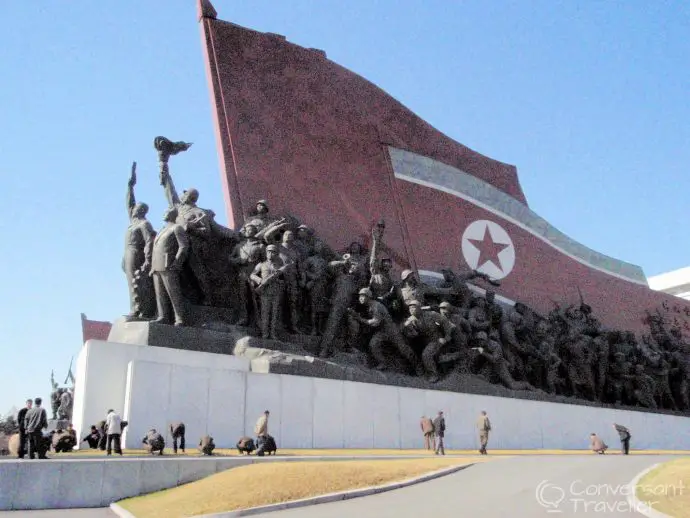
One of the newest buildings in Pyongyang is the Victorious Fatherland Liberation War Museum, inside which we could not take photographs. It reputedly cost an equivalent of $25 million and was built in just 11 months. We were the only people there. This place must have been especially difficult for US tourists as the anti-American sentiment goes into overdrive. The museum is built to pay homage to the soldiers who fought in the Korean War, and essentially tells the visitor of how the innocent Korean people were attacked by the evil Americans and South Koreans but valiantly defeated them. It contains many extremely graphic photographs of injured, dead and mutilated American soldiers and dioramas of battlefield scenes in which brave, victorious Korean soldiers stand over the dead bodies of the criminal aggressors whose bodies are being eaten by crows. There are even sound effects of crowing in the background.
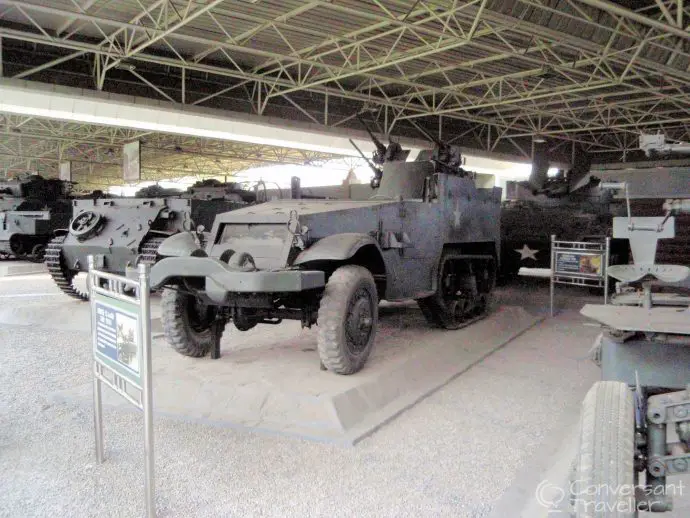
Pride of place in the grounds of the museum is the USS Pueblo, a US warship captured by the Koreans in 1968 complete with the surrender notes written by the Pueblo crew. I found this quite amusing as the language used in the surrender notes is very un-American and fawning towards the Great Leader and his superior army. It’s quite obvious to a westerner that these notes were either composed entirely by the Koreans or the American servicemen were taking the mickey.
The Grand Peoples Study House in Kim Il Sung square is the “Centre for the project of intellectualizing the whole of society and a sanctuary of learning for the entire people. A place where citizens can…develop a greater love and respect for the Kim family”. Our guide explained that with over 600 rooms, more than 1000 people per day come to study the Juche theory, the history of the Kim dynasty and listen to recordings of Kim Il Sung’s “on the spot guidance”. Apart from a few people in an English language class we were the only people there.
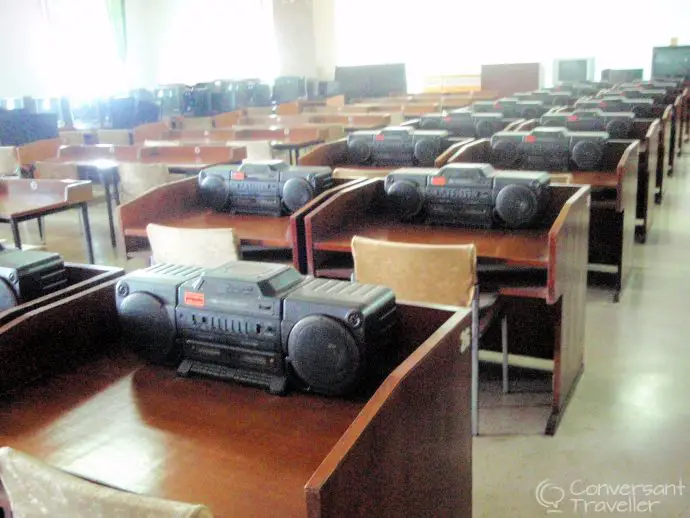
Any tour will essentially made up of visits to see statues, buildings, paintings and monuments built to honor the Kim dynasty. These monuments are very extravagant and always illuminated after dark. Some of them will deliberately be slightly larger than their global counterparts. Pyongyang’s Arch of Triumph (built to commemorate the Korean resistance to Japan from 1925 to 1945) is 10m meters taller than Paris’s Arc de Triomphe.
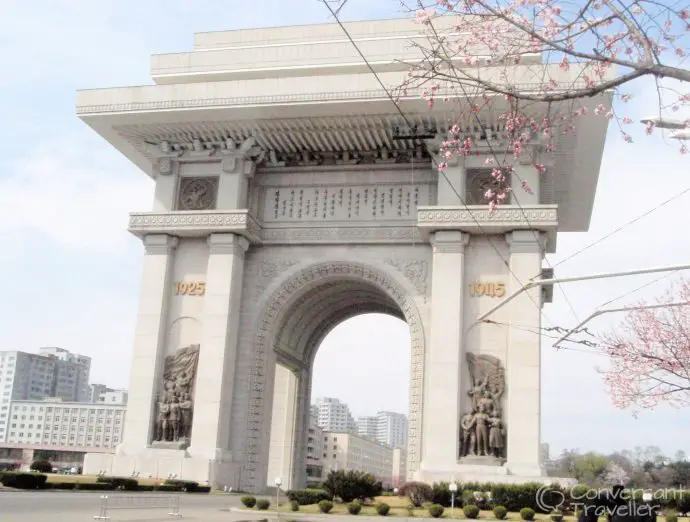
All have supposedly been built in response to the peoples’ demand to show their love of the Great Leaders, yet from 1994 to 1997 somewhere between 240,000 and 3.5 million people died of starvation in the DPRK. Today most North Koreans have an average daily food intake of just 700 calories and only eat meat on public holidays, namely the birthdays of Kim Il Sung or Kim Jong Il. In rural areas reports of cannibalism are common. But apparently this is ok, since they have great statues instead.
The roads look really wide, but where are all the cars?
The roads are in terrible condition, with lots of potholes and ruts. I’ve read that the width is to enable tanks and military equipment to move around easily, and there are lots of images of the military processions through Kim Il Sung square.
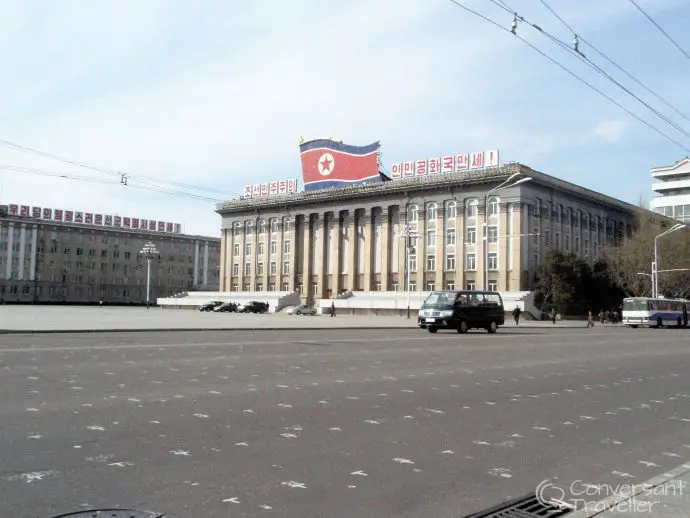
The lack of traffic is quite odd in a large capital city. This is one of the strangest things about a visit to North Korea. People travel by public transport, namely ancient trolley buses. As DPRK is a communist state, private car ownership is very rare, so most cars are taxis or staff cars for workers party members. The most interesting vehicles are the ancient green Volvos. Apparently in the 1970’s Volvo “won” a contract to supply the Government with staff cars. The Swedes have allegedly still not been paid for these vehicles but the cars remain one of the most common in Pyongyang. They are quite an iconic Pyongyang sight. Mexico has its VW Beetles, Cuba has its old American saloons and Pyongyang has its green Volvos.
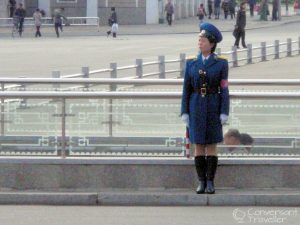
Another iconic sight on Pyongyang streets is the traffic girls who direct traffic at junctions as the electricity is “temperamental” and traffic lights unreliable. The position is highly sought after and the girls take the job very seriously. I always waved at the girls from the bus, they never waved back but often smiled!
It seems a bit like a grim and inaccurate theatre production, so was there really any point in visiting North Korea if most of it isn’t real?
This is another thing that people talk about when asking what is it like to visit North Korea. Many things I’d read about DPRK told me that visitors will never see the real DPRK, and that Pyongyang is just a showcase city which in way no represents the rest of the country. I decided I still wanted to visit, as even if this were true, such an elaborate charade would be an amazing thing to experience.
On arrival I quickly discovered that the rumours weren’t entirely true. Yes, you do mainly see only what your guide allows, but you also see plenty of the real Pyongyang and meet many local citizens. Some will smile and acknowledge you, some will stare, and some will look straight through you.
I fully agree that Pyongyang is most probably not a true representation of the DPRK but it still incredible to visit a city that is vastly different from any other on Earth.
In order to visit safely, did you feel you had to pretend to be something you weren’t and support the regime by adhering to its cult rules?
When visiting any country I always try to respect their culture and DPRK was no different for me. I was aware of the cult-like worship of the Kims and the anti-American sentiment. I knew I would have to bow before statues and listen to lots of propaganda and false accounts of history. I mentally signed up to this before I left the UK and thus never felt unsafe.
I would strongly recommend that anyone planning to visit DPRK does the same. Disrespecting or mocking the regime will only lead to the tour being ruined for everyone as the KITC guides will just end the tour. The guides could also be punished for losing control of their group. If you were VERY disrespectful you could end up in jail. The Koryo guides fully explain the do’s and don’ts of expected behaviour prior to the trip and if you think you cannot accept it then don’t get on the plane.
Has your knowledge and understanding of North Korea increased as a result of your visit, or are you even more confused about the reality of the country?
I am definitely even more confused about DPRK now. I discovered that many of the things I’d heard in the media were little more than exaggerated myths made believable only because they are about DPRK. Checking in for the flight at Beijing a Korean man in workers clothes was checking in his 44inch Sony Bravia TV. If the regime is so bad people are defecting in droves why was he going back? In some ways, despite how bizarre the whole place is, it also seems so normal. Kids going to school with back-packs smiling and laughing at the foreigners, teenagers playing basketball in the park and people just going about their business, chatting on cell phones, laughing with friends just like in any other city. It’s very difficult to explain, in some ways I was totally overwhelmed by how alien and strange Pyongyang felt and in other ways I was amazed by how normal it felt for a country which is “On the Axis of Evil”.
Do you think the North Korean people you spoke to believed in what they were telling you and were genuine in their devotion to their leader, or do you think it really was just all a show for the tourists.
This is a difficult question, and I think the answer is down to personal opinion. For example, one night in our hotel the TV above the bar was showing a music show. As it finished footage of Kim Jong Un came on the screen. The three young barmaids immediately stopped what they were doing and were fixated by the screen, clapping and clutching each other in excitement. It was like how teenage girls in the UK might behave if One Direction were on screen. I decided there were possibly three things could explain this:
- They really are in awe of Kim Jong Un and feel a genuine amazing love and respect which they cannot hide.
- They were putting on a show for the tourists to make us believe that the people of DPRK really do adore and respect the Kim Dynasty.
- They were trying to outdo each other, because not showing enough respect might lead to them being reported. Rewards are reputedly given to people who snitch on other citizens for not being respectful enough.
I’m still not sure, you can make your own mind up on this one.
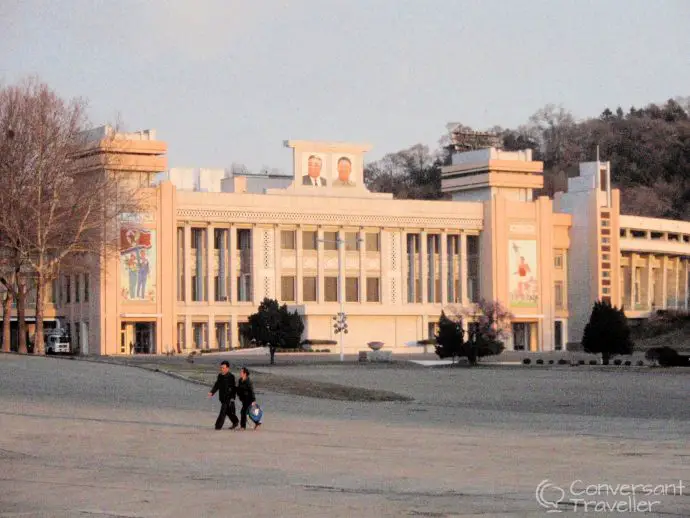
Can you confirm or disprove any of these popular myths?
Kim Jong Un’s image is everywhere and must not be dishonoured in any way
Absolutely true. Every TV news programme, magazine and newspaper will mainly consist of what Kim Jong Un did, visited, wore or said yesterday. Any image of Kim Jong Un (Or any of the Kims) must be treated with utmost respect. When folding a newspaper you must never crease it through the picture of Kim Yong Un (his picture is on the front cover every day). Newspapers should also never be put in the bin, just folded and left. Koryo tours recently had to write a very long grovelling apology to KITC because a guest put a newspaper in the bin in his hotel room. I don’t know where they all go, I can only imagine there’s a huge warehouse somewhere full of old newspapers and magazines!
Tourists can’t take photographs
This turned out to be bit confusing. We were told by the Koryo guides that we should not take pictures of military vehicles or personnel, shop windows or people without asking first. When visiting the various monuments and statues we were told to ask before we took pictures. We all complied but there seemed to be no consistency. At one place we would be stopped from taking photos then at the next they would ask “why are you not taking pictures? Do you not think this statue is very impressive?” Guides were strict about military vehicles and personnel but I don’t think it was through fear of westerners stealing ideas of their superior products since most of the vehicles were 30 or 40 years old.
You can’t even go to the bathroom without an escort
You can certainly go to the bathroom unescorted. I was surprised just how much freedom we got compared to what I’d read. Although we always had to be with our guides when walking the streets of Pyongyang our group often became very stretched out. To our surprise, when this happened on the way to catch a bus, the KITC guide gave us front-runners directions to the bus stop and told us to go on ahead while she waited for the stragglers. After a short while I looked to the guy next to me and said “Are we unaccompanied here?” And we were. It did feel quite strange, but not at all scary, and some kids playing basketball in a park all waved and smiled at us. It was one of those times when Pyongyang felt quite normal.
The subway is used only for tourists and the locals are all actors
I had read this also, but it definitely proved to be a myth, it was just a regular subway if not as busy as most capital cities. Our KITC guides were also aware of this myth, asking us in the bar later if we enjoyed meeting all the actors on the subway. They have humour too!
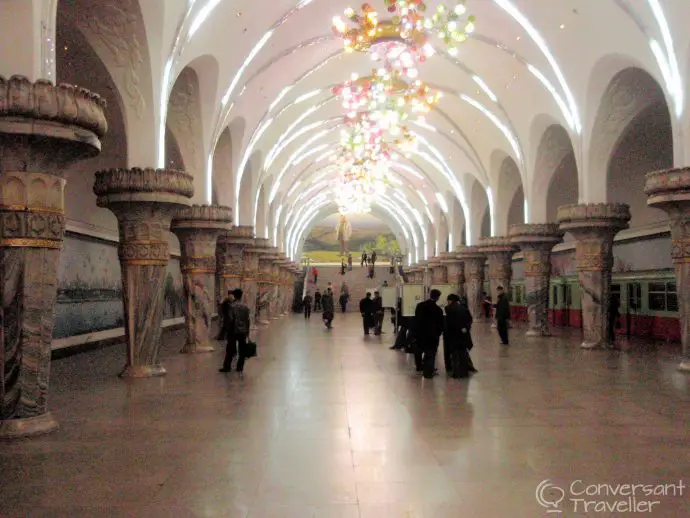
There is no currency
We were told that for many years people were paid mainly with vouchers which they could redeem in stores through the city along. Now cash is becoming common but only to members of the workers party, and in rural areas vouchers are still the main form of payment. Foreigners are not allowed to have DPRK Won. In the big hotels Euros, Chinese Yuan and US Dollars are the main forms of accepted currency (although the US Government does not really want this happening).
Everyone in North Korea must have the same hair cut as Kim Jong Un
This was another myth our KITC guides were aware of and thought was really funny. The answer is no, however most men do have their hair shaved close at the back and sides and longer on top. When I asked our guide Mr. O about this he laughed and went on to ask me if people in the UK ever copy the hairstyles of famous movie stars or sports stars. When I replied to the affirmative he just smiled and said “Not so different then”.
Again, make your own mind up on this one.
And finally, were there any unicorns?
Sadly no unicorns, double rainbows or flying horses. Maybe next time…
A huge thank you to James for sharing his thoughts and experiences!
Found this post useful? Why not pin it for later…
I have to admit, as fascinating as it sounds, I’m still not convinced I’d ever want to visit North Korea. I think I’d feel like a hypocrite in the world’s biggest pantomime, not knowing where reality ended and fantasy began. Yet for the curious traveller who yearns for thrilling experiences in a world where new discovery through exploration is confined to outer space and subterranean depths, to visit DPRK would be a once-in-a-lifetime opportunity to peek under the cover at the world’s last enigmatic and secretive regime. Perhaps the true final frontier.

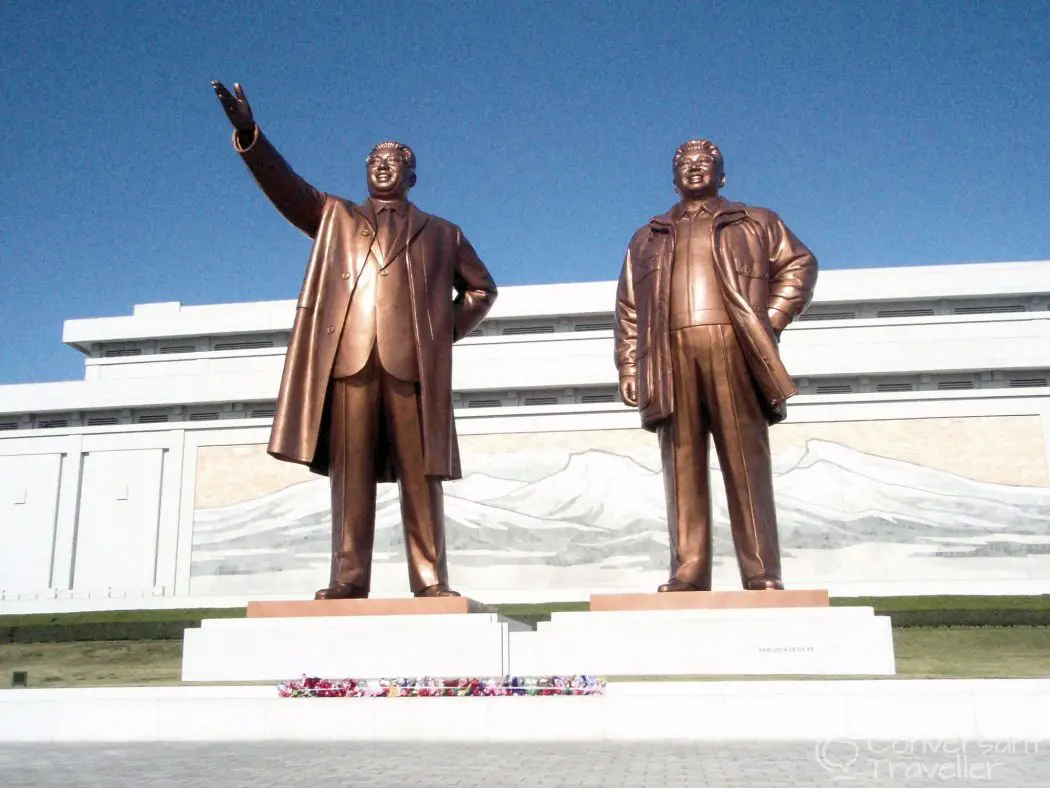
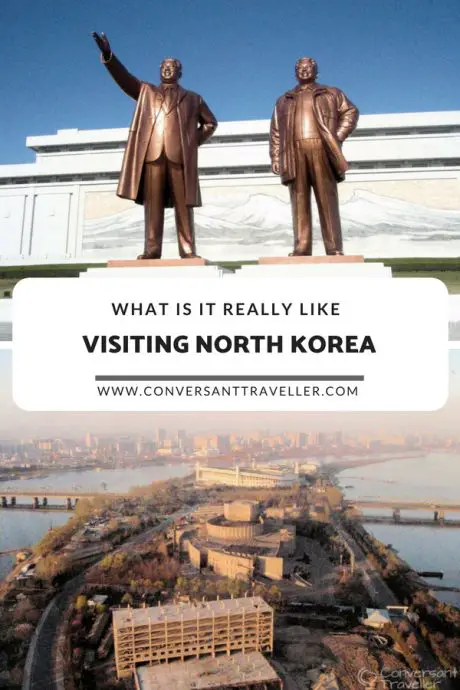
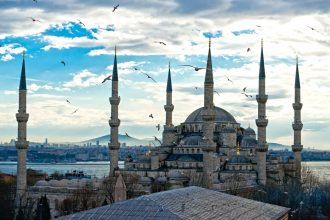
This reminds me of my trip to the Cu Chi tunnels in HCMC. The videos were still incredibly anti-American in 2015 and although I am British I found it quite disturbing that anyone would be celebrating the death of another human being. This city sounds fascinating but I find the rhetoric as bad as Muslim terrorists saying we are all western heathens or western governments suggesting that all communist states are evil. It sounds to me like a classic case of simply struggling to understand one another!
It really is a totally alien outlook on life (or death!) isn’t it. Interesting that you had a similar experience in Ho Chi Minh, it really does show the differences between cultures doesn’t it.
This is wonderful! I did my graduate thesis paper on North Korea and am in awe that you went.
Now that’s a great topic for a thesis, such a fascinating subject isn’t it!
I know I’ve read this post before months ago, and re-reading it again, I’m just as intrigued as I was the first time! North Korea is definitely on my list — just to get the chance to see these unusual experiences and scenarios for myself is part of the draw!
It really is one of those places you just have to see to believe isn’t it. I think this is my most read post, it’s great to know others want to experience it too!
As a friend and colleague of James, I have listened to his stories about his travels and it was only the other week he told me about North Korea. I was fascinated and he directed me to this blog. What a fantastic piece of informative writing.
Glad you enjoyed it, certainly the most fascinating place I’ve ever had the pleasure of writing about, and thought James’s story deserved a spot on the blog. Thanks for reading!
That was a remarkable article on a place I had no idea was even possible to visit. As for going there myself I am of two minds. I went to Tibet in the 90’s and some of what I saw there was a charade but enough of it was real that I was able to get a good sense for the good and bad. Here sounds like a peek under the covers is itself a charade. Incredibly interesting but pretty sure I would not want to contribute to this regime coffers. I am still blown away that a visit is even possible. Great article.
I think if you were visiting you’d have to do it because you wanted to experience the charade, in itself a rather unique thing to do, rather than to see the real country. It’s so sad what has happened to Tibet, would have loved to have seen it pre-China but don’t want to go now as I know it won’t feel real. Glad you managed to make something of your trip there!
Wow, thanks for the article!
I haven’t read any article that well written and interesting about North Korea before. When reading this I tried to convince my boyfriend to go there with me some time. Unfortunately he doesn’t want to go – yet! Haha 🙂
I am totally going to follow your blog. Love your way of writing.
Ah, thanks, it’s great to know you enjoy reading my ramblings!I loved writing this piece as it’s all still so unknown and mysterious. Perhaps you should just go without your boyfriend? 🙂
This is such a cool thing to do, well done you!
Thanks, my friend James said it’s one of the best experiences he’s ever had!
This is a really interesting post! It is definitely very difficult to get a clear insight into what’s happening exactly and it is too easy to believe all the rumours. It would definitely be an interesting place to visit – thanks a lot for the article!
Thanks, hope it inspires other people to realise travel here is possible!
We passed on North Korea when we had the chance…I can’t help but think there will be a better time to go.
I think it depends on what you want to experience…there is nowhere in the world like it, and with time this may change, hopefully for the better for it’s inhabitants, but possibly to the detriment of visitors wanting to experience something so unique. So perhaps there’s no time like the present!
Thanks for sharing your thoughts on North Korea. You’ve introduced some very interesting facts and reasons why people shouldn’t be afraid to visit. Honestly, it’s one country I didn’t think I’d want to visit…have to rethink that now!
Certainly an eye-opener isn’t it!
This is really informative and I have to say not a place that I have even researched about traveling – or even thought we could. Very interesting thank you for sharing. 🙂
Any time 🙂
Great article. I’m so intrigued by these tours and have heard lots of different versions of what happens so it was great to read a first hand account!
Really enjoyed reading this one Heather! What a fascinating place!
Thanks Kayna, glad you enjoyed it 🙂
I am likely going to be going there next spring, so it was very interesting and useful to read this interview and get a good idea of what I can expect. The part about the power being turned off at night is a little freaky, so it’s DEFINITELY good to be prepared for that!
Have a great trip, will be interested to hear your thoughts when you get back.
I had no idea you could visit North Korea,! Thanks for sharing photos of a little visited place. I do have to say its not at the top of my to see list.
I had no idea you could take a tour to North Korea! I hope one day things improve enough to make the country more accessible and better for its own people.
Great article..! It’s always fascinating to read about North Korea. Friends of mine went there for their honeymoon (!) and wrote about it on my site 😉
Thanks for sharing, it’s important people know how it goes over there.
Wow, a honeymoon? That’s rather different, bet there’s few other people in the world who can say they did that! Hope they enjoyed it.
Kudos to you for having the guts to undertake what some of us wouldn’t dare to. And thanks for debunking so many myths! This post has been an enjoyable eye opener!
It was James who had the guts, but one of the most fascinating tales I’ve had the pleasure of hearing! Definitely an eye-opener.
That’s really interesting. It sounds a bit like Russia in the communist days – of course, the reality there was much more complex than the myths.
I love this post!! North Korea is strangely somewhere that I’ve wanted to visit for a long time.
Hope you get there one day Cory, would be interesting to hear your perspective on getting around!
Fascinating post! I really enjoyed seeing some pictures of the country. Everything seems bizarrely intriguing, from the hotel down to the boomboxes at the Study House. I hope to make it there at some point in my travels.
If you do, I’d love to hear about what you think, it seems to be a place that evokes so many differing opinions.
This is such an informative article! I know some people who have visited North Korea, we were even thinking of doing it while we were in Seoul but it wasn’t something that was on top of our list. Perhaps one day when we are a bit more adventurous although I am highly curious to experience it for myself.
I think it’s a place for the curious, not something you can experience anywhere else!
I absolutely loved reading this. I am very fascinated by North Korea..also I would probably never go there myself.
What a fascinating read. Not a place I would visit so really enjoyed reading your perspective.
Very interesting article! It is definitely one of the countries I want to visit…I´ve heard from other travellers that there is a way to get a travel permit or something like that and then you don´t need to have a guide, have you heard of anything like that? Maybe coming from an ex-communist country they will be not as strict…And that subway is beautiful, reminds of the one in Tashkent, Uzbekistan – the most beautiful one I´ve seen so far…it feels more being in a museum than a subway 🙂
I’ve not heard about the travel permit, would be interested to know if this is true! Subways are amongst some of the most overlooked beautiful architectural works of art, would love to visit Tashkent one day!
I have to admit, I have wanted to visit N. Korea for a long time now. I find all the accounts of people that have been there to be fascinating. I can understand why it is it not the best idea though. This seems like a very honest and insightful account of this guys experience. Thanks so much for sharing!
Pleasure 🙂
With the situation in NK it never appealed to me to go there, this article is interesting though.
Damn, I’m a journalist with a great desire to visit North-Korea! Guess I’ll have to try harder 🙂
Some of you do get in otherwise how’d we know so much about it!? 🙂 Would love to hear about it if you do.
This is a very interesting article and the first I’ve read about the country. I’m not sure I’d be curious enough to visit myself though. It really does sound like a world of its own, very far removed from the rest of the world.
Very interesting post! I’d love to visit North Korea too, but independently, not as part of a tour. Do you think this is possible?
You can’t visit unless on an official tour, which is why I think I’d struggle, but it sounds like they’re becoming more flexible each year, Koryo even offer camping trips now!
This is a really interesting article! I had no idea that tourists can go to North Korea. It does sound like something that you would have to do your research and kind of mentally prepare for, but it seems worth it to be able to go there. I think just from reading this, it does sound a little like a big theatrical production, but that is a big draw for me!
I totally loved this. I watched the Vice documentary on North Korea, and it seemed like a pretty unusual place. I have to say I probably won’t go any time soon, for fear that I might be flagged, considering my political views, and activism on the many crimes of Communism throughout history.
I’ve seen the documentaries too, and whilst I may not be jetting off there any time soon, I’ve still found it more fascinating than all the other traveller tales I’ve ever heard.
Wow, that was a really interesting read. North Korea has always fascinated me and I really like reading different people’s accounts. It seems like everyone has a different experience! I’m not sure if I’d want to go, but reading about it is pretty interesting.
I found this to be a very fascinating article, although I would never even entertain the notion of visiting NK. I wouldn’t be able to hide my disdain towards a leader who is so plump and well-fed while many of his people starve. I do believe there are some exaggerations in the media, but I don’t discredit the first-hand accounts of those who have escaped NK.
I think it’s always going to be a huge talking point with so many different opinions, which is probably why it’s so fascinating.